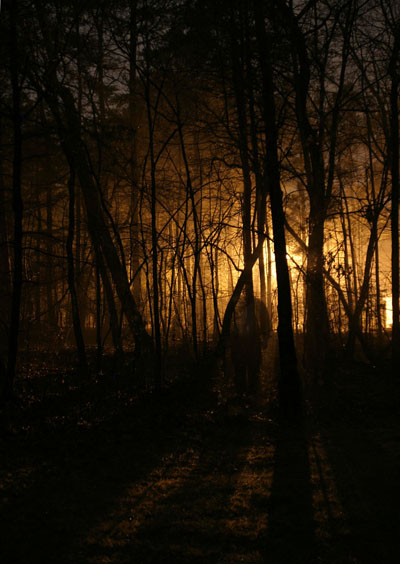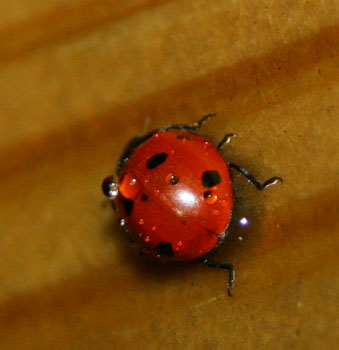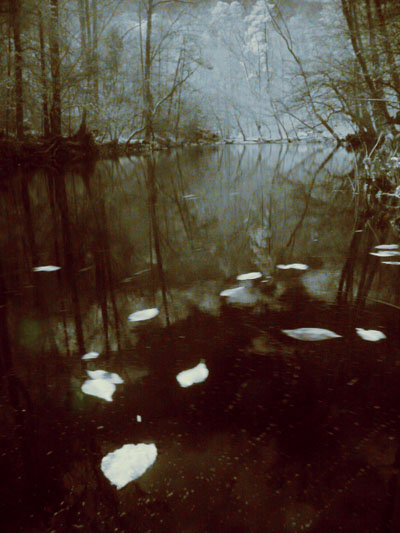I’m looking at the posts here and realize it’s been a month since my last one, which isn’t good. So to make it up to my remaining one (maybe two) readers, I’m going to throw up some quick stuff before I get to a much longer post picking on religion again.
 In the past couple of weeks, I’ve been doing little more than experimenting. One a foggy night recently, I went out to try and accomplish one of the images I’ve planned for just such conditions. As is often the case with these experiments, they didn’t come out quite as intended, meaning I’ll have to try again when we get a nice nighttime fog. But something else that I tried on a lark came out reasonably well, I think, though perhaps not as strongly at this size. I’ve been toying with posting it to some ghost forums just to see how much it can stir up – and how few can actually figure out that it’s a simple, and common, photographic effect. Technically, not a double-exposure, since it’s only one long exposure, but when your model (in this case me) isn’t in position for the entire exposure, a certain amount of light shows “through.”
In the past couple of weeks, I’ve been doing little more than experimenting. One a foggy night recently, I went out to try and accomplish one of the images I’ve planned for just such conditions. As is often the case with these experiments, they didn’t come out quite as intended, meaning I’ll have to try again when we get a nice nighttime fog. But something else that I tried on a lark came out reasonably well, I think, though perhaps not as strongly at this size. I’ve been toying with posting it to some ghost forums just to see how much it can stir up – and how few can actually figure out that it’s a simple, and common, photographic effect. Technically, not a double-exposure, since it’s only one long exposure, but when your model (in this case me) isn’t in position for the entire exposure, a certain amount of light shows “through.”
By the way, it is fairly simple to do a multiple-exposure with a digital camera (just in case you were wondering.) Simply lock the shutter open on bulb setting and place the lens cap after the first exposure, then remove it for the subsequent exposures. Don’t argue with me that it’s only one exposure – think about what “exposure” means and realize that it’s not referring specifically to a shutter trip.
 As I was about to sit down to work on something tonight, it began pouring outside, and since we’ve had some nice warm weather recently, the frogs have come back out – someplace not far outside my window a treefrog started calling. I went outside with a pair of flashlights but still didn’t find it (little bugger got nervous as I got close and stopped calling,) but I did find a ladybug in not-so-typical conditions. I didn’t stay out long because it was raining too hard to do much photography, and both my jacket and the light camera bag are drying out now.
As I was about to sit down to work on something tonight, it began pouring outside, and since we’ve had some nice warm weather recently, the frogs have come back out – someplace not far outside my window a treefrog started calling. I went outside with a pair of flashlights but still didn’t find it (little bugger got nervous as I got close and stopped calling,) but I did find a ladybug in not-so-typical conditions. I didn’t stay out long because it was raining too hard to do much photography, and both my jacket and the light camera bag are drying out now.
And finally, I spent some time a few weeks ago trying to shoot some images for a contest. I’ve never been much for contests, largely because they’re frequently a cheap ploy to get promotional images for free – check the rules and you’ll usually find that the photographer gives up most or all rights to the photos, regardless of whether any award has been provided. A local aquarium in Florida once solicited numerous images from the public for their calendar, and not only were they not willing to pay for any images (nor were they even holding a contest,) they wanted photos of some outright dangerous species like jellyfish and mantis shrimp, which I felt was piling irresponsibility on top of cheapness. Of course, they promised “exposure” to the photographer by printing their name with the image, woo hoo! “Exposure” does not mean, “listing the credit you should be obligated to give automatically,” and the value of such can be measured in… um, well, it can’t be measured, really, because it’s almost meaningless. Nobody sees a credit line and says, “I’m going to seek that photographer out to buy photos from!” Most people don’t even see the credit line. Get paid for your images, and you’ll even get that “exposure” on top of cash! You’ll also send a message to editors and buyers that you’re able to do business, and didn’t simply submit a lucky shot to a contest.
 Oh, yeah, the contest! Anyway, this one has much more reasonable terms, so even though I have plenty in stock, I also started looking for potential shots that would fit their criteria better. Along the way, I was experimenting again, this time with infrared. I’ve talked about infrared on the site here and here, and I like trying to see what I can produce with it. Digital sensors can usually capture infrared light, but it some manufacturers filter it out. You can do a simple test and aim a TV remote into the lens and see if triggering the remote results in a tiny light in the digital image. If it works, then you can get an IR pass filter that blocks most visible light (like, in the case here, a Lee 87C polyester) and start playing on sunny bright days. Have a tripod, because there isn’t much infrared compared to visible light, so you’ll need long exposures (there’s that word again.) But you’ll see that foliage reflects the most infrared, and the sky and water reflect the least. You’ll probably end up with a nearly B&W image, because the color filters on digital sensors let IR pass almost equally (if that didn’t make sense, maybe this helps explain it a bit – look at the sixth paragraph.) In this case, I enhanced what little color was there and tweaked it a bit, producing an effect I really liked from the background trees. It didn’t fit with the contest guidelines, but I like it for its almost-spooky quality. It becomes perhaps even more interesting to know that this was a brilliantly sunny day and was not taken in shadow at all.
Oh, yeah, the contest! Anyway, this one has much more reasonable terms, so even though I have plenty in stock, I also started looking for potential shots that would fit their criteria better. Along the way, I was experimenting again, this time with infrared. I’ve talked about infrared on the site here and here, and I like trying to see what I can produce with it. Digital sensors can usually capture infrared light, but it some manufacturers filter it out. You can do a simple test and aim a TV remote into the lens and see if triggering the remote results in a tiny light in the digital image. If it works, then you can get an IR pass filter that blocks most visible light (like, in the case here, a Lee 87C polyester) and start playing on sunny bright days. Have a tripod, because there isn’t much infrared compared to visible light, so you’ll need long exposures (there’s that word again.) But you’ll see that foliage reflects the most infrared, and the sky and water reflect the least. You’ll probably end up with a nearly B&W image, because the color filters on digital sensors let IR pass almost equally (if that didn’t make sense, maybe this helps explain it a bit – look at the sixth paragraph.) In this case, I enhanced what little color was there and tweaked it a bit, producing an effect I really liked from the background trees. It didn’t fit with the contest guidelines, but I like it for its almost-spooky quality. It becomes perhaps even more interesting to know that this was a brilliantly sunny day and was not taken in shadow at all.
I discovered something else, too: apparently even long-dead leaves retain their ability to reflect infrared, so they stood out nicely on the water. I’m pleased with it.



















































